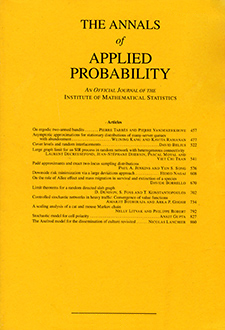Abstract
According to a 1975 result of T. Kaijser, if some nonvanishing product of hidden Markov model (HMM) stepping matrices is subrectangular, and the underlying chain is aperiodic, the corresponding α-chain has a unique invariant limiting measure λ.
Here the α-chain {αn}={(αni)} is given by
αni=P(Xn=i|Yn,Yn−1,…),
where {(Xn,Yn)} is a finite state HMM with unobserved Markov chain component {Xn} and observed output component {Yn}. This defines {αn} as a stochastic process taking values in the probability simplex. It is not hard to see that {αn} is itself a Markov chain. The stepping matrices M(y)=(M(y)ij) give the probability that (Xn,Yn)=(j,y), conditional on Xn−1=i. A matrix is said to be subrectangular if the locations of its nonzero entries forms a cartesian product of a set of row indices and a set of column indices.
Kaijser’s result is based on an application of the Furstenberg–Kesten theory to the random matrix products M(Y1)M(Y2)⋯M(Yn). In this paper we prove a slightly stronger form of Kaijser’s theorem with a simpler argument, exploiting the theory of e chains.
Citation
Fred Kochman. Jim Reeds. "A simple proof of Kaijser’s unique ergodicity result for hidden Markov α-chains." Ann. Appl. Probab. 16 (4) 1805 - 1815, November 2006. https://doi.org/10.1214/105051606000000367
Information





